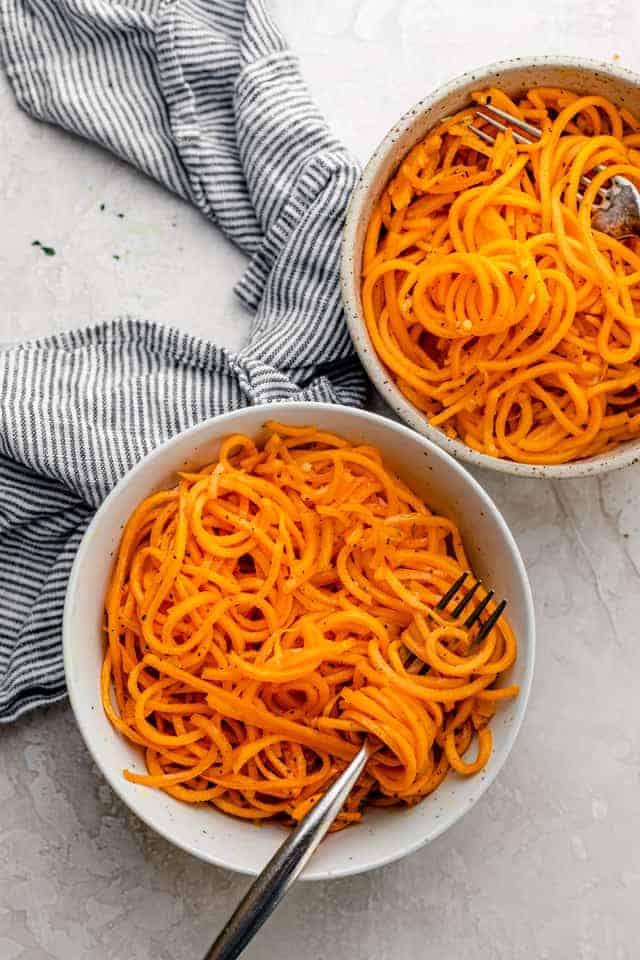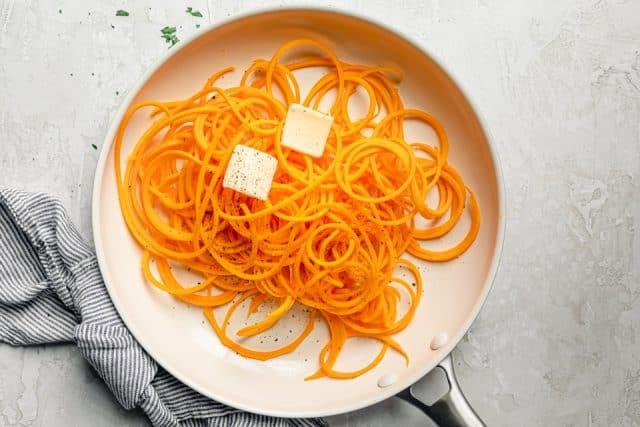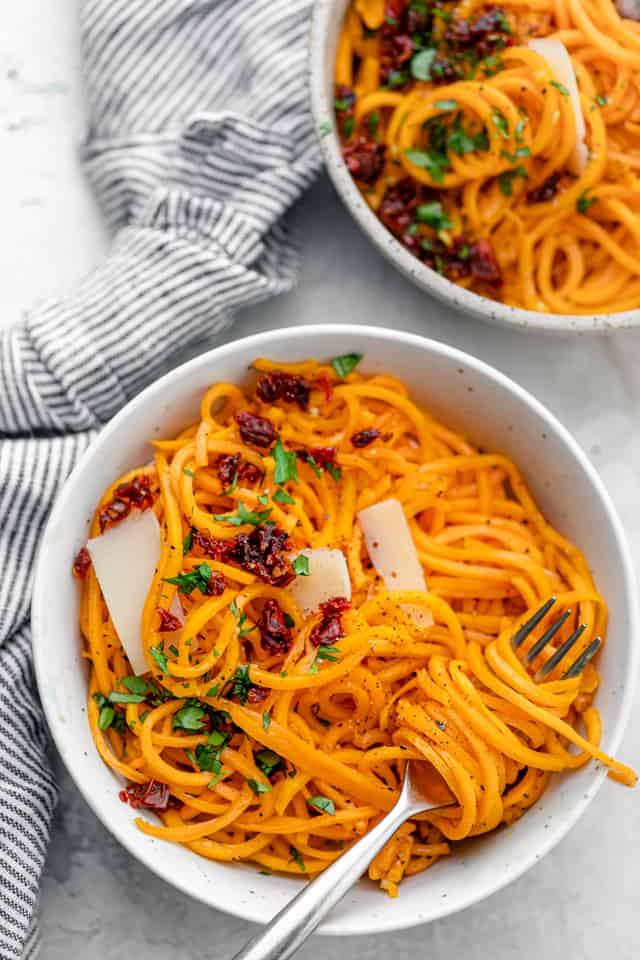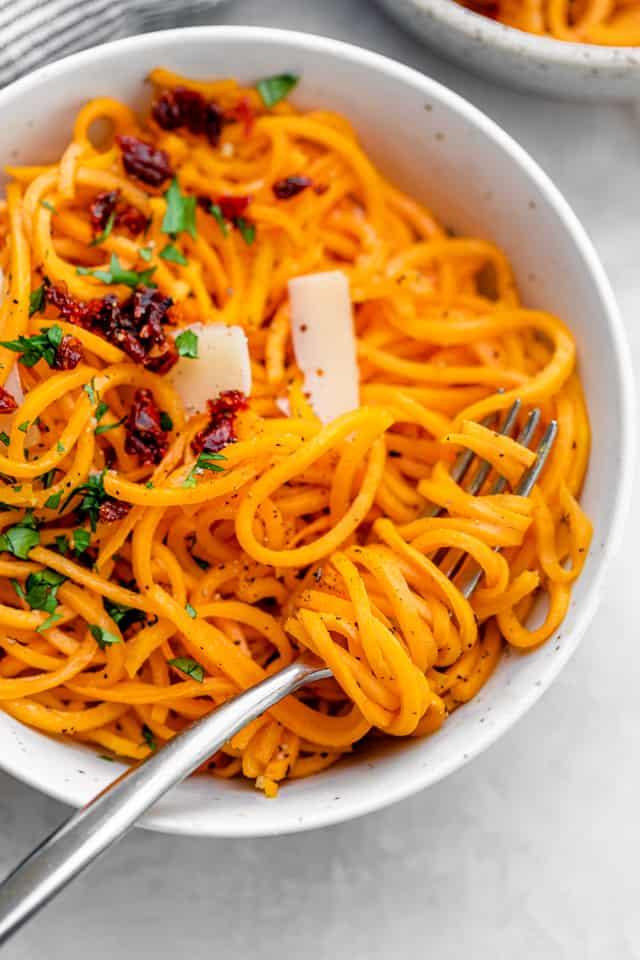If you’re on the hunt for a low-carb noodle alternative that’s as vibrant as it is delicious, look no further than these Butternut Squash Noodles. Whether you prefer them simply seasoned with salt, pepper, and butter or drenched in a creamy sauce like Alfredo or marinara, these fall-inspired low-carb noodles are sure to satisfy your cravings. Let’s dive into the details and learn how to make these colorful veggie noodles!

How to Cut and Peel Butternut Squash
Butternut squash has a distinct shape, with a wide neck that contains the seeds. To prepare it for noodle-making, you’ll want to slice the squash where the shape transitions from the tube to the wide neck. You can save the wide piece for later use, as it can be peeled, seeded, and chopped to make a delicious roasted side dish.
Next, trim off the end of the neck, creating a stable base for the squash on your cutting board. Use a knife or vegetable peeler to remove the skin. And here’s a little secret: out of all the veggies I’ve spiralized, butternut squash is the most challenging one to handle. So, I recommend using a strong and sturdy spiralizer, like the Paderno spiralizer, to tackle this job. Also, opt for the thickest blade to effortlessly spiralize the butternut squash in just a few minutes.

How to Cook Butternut Squash Noodles
Whether you make the noodles from scratch or purchase pre-prepared butternut squash noodles, there are three simple cooking methods at your disposal: boiling on the stovetop, sautéing on the stovetop, or roasting in the oven. While you could also microwave the noodles, it’s worth noting that this method may not yield the best texture.
Boil on Stovetop
To boil the butternut squash noodles, just like spaghetti, place them in a pot of salted boiling water for 2-4 minutes. Although this is my least favorite method, it works well if you’re already boiling pasta or mixing half pasta with half noodles. Just be sure to monitor the squash, as you don’t want it to become too soft.
Sauté on Stovetop
For a flavorful twist, start by sautéing some aromatics (like onions or garlic) in fat (such as olive oil or butter). Then, add in the butternut squash noodles and sauté them for 7-10 minutes, tossing them with tongs to ensure even cooking. As they cook, the noodles will shrink down and become tender. Feel free to finish off the dish with fresh herbs, cheese, or other add-ins like sun-dried tomatoes, roasted red peppers, or olives.

Roast in the Oven
If you’re a fan of roasting root vegetables, you’ll love this method. Line a baking sheet with parchment paper, or place the butternut squash noodles directly into a casserole dish with some seasoning and butter or olive oil. Roast them in the oven for a quick 10 minutes. This approach requires minimal effort and yields fantastic results!
When choosing a cooking technique for your butternut squash noodles, consider the other dishes you’re serving. For example, sautéing works well if you’re already using the stovetop to cook pasta and shrimp for pesto spaghetti. On the other hand, roasting pairs perfectly with oven-baked salmon.
Tips for Making Butternut Squash Noodles
Now that you’re armed with the knowledge of how to make perfect butternut squash noodles, here are some tips to ensure exceptional results:
- Use the long, thin neck part of the butternut squash for spiralizing. The bulbous bottom part, where the seeds are, is not ideal due to its uneven shape and the presence of seeds in the middle.
- Avoid overcooking the butternut squash noodles. Regardless of the cooking method you choose, keep an eye on them, as they can quickly turn too soft. Aim for a fork-tender consistency that allows you to twirl the noodles on a fork without them breaking apart.
- Season the noodles while you cook them; doing so will enhance their sweet and nutty flavors. On their own, butternut squash noodles can be a bit bland, so add your favorite seasonings before cooking to bring out their delicious taste.

Frequently Asked Questions
What to do with butternut squash noodles?
Here are a few ideas to get you started:
- Use them in a salad, like my Asian Noodle Salad recipe.
- Add them to spaghetti dishes, such as Spaghetti and Marinara.
- Serve them as a side dish with your favorite protein and vegetables, just like my Sweet Potato Noodles.
- Make egg nests and bake or fry them with eggs for a delightful breakfast or brunch option.
What sauce goes well with butternut squash noodles?
If you prefer to savor the natural taste of butternut squash noodles, I recommend keeping it simple with butter or olive oil, salt and pepper, and a sprinkle of Parmesan cheese. However, the sweet and nutty flavor of butternut squash pairs wonderfully with creamy sauces like Alfredo or mushroom sauce.
Can I freeze butternut squash noodles?
Absolutely! Freezing butternut squash noodles is possible, but if you plan to freeze them, it’s best to do so before cooking. Squash retains a lot of water, and freezing and thawing can result in a mushy consistency. To freeze the uncooked butternut squash noodles, place them in a freezer-safe container or bag and store them for up to 3 months.

More Squash Recipes to Explore:
- Roasted Butternut Squash Soup
- Butternut Squash Risotto
- Butternut Squash Mac and Cheese
- Baked Butternut Squash Fries
- Kousa (Stuffed Squash)
More Low-Carb Dinner Recipes:
- Healthy Shrimp Scampi
- Zucchini Enchiladas
- Beef and Broccoli Stir Fry
- Baked Eggplant Parmesan
If you’ve given this healthy yet satisfying Butternut Squash Noodles recipe a try, or any other recipe from FeelGoodFoodie, don’t forget to rate the recipe and leave a comment below! I’d love to hear about your experience making it. And if you capture some mouthwatering shots of the dish, share them with me on Instagram, and I’ll be sure to repost them on my stories!
Ekilove – For delicious, wholesome recipes that make you feel good!



